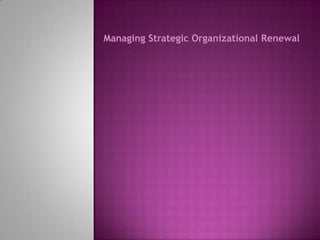
Managing strategic organizational renewal
- 1. Managing Strategic Organizational Renewal
- 2. Strategic Overview Select, train, and organize employees Previously focused on the training and management development methods Concepts and skills you need to more successfully implement organizational changes
- 3. Managing Change – What Do We Change? Strategic change – a company’s strategy, mission and vision Cultural change – a company’s shared values and aims Structural change – reorganization Developmental change – people’s attitudes and skills Technological change – work methods
- 4. Cultural Change Five ways to achieve cultural changes: Make it clear to employees what you pay attention to, measure, & control React appropriately to critical incidents & organizational crises Deliberately role-model, teach & coach the values you want to emphasize Communicate priorities by how you allocate rewards & status HR procedures & criteria consistent with values you hold
- 5. Technological Change Technology is a powerful engine of change Creates change by modifying the work methods organizations use to do tasks Results in reengineering work process Must apply HR methods: Teamwork New job descriptions Boosting skill & knowledge levels More flexible work arrangements
- 6. Lewin’s Process Leading Change 3 steps Unfreezing Moving Refreezing
- 7. Ten-step Change Process Mobilize commitment Communicate that vision Urgency Create a guiding coalition Develop a shared vision
- 8. Monitor progress & adjust vision Ten-step Change Process Anchor new ways in culture Consolidate gains Generate short-term wins Help make the change
- 9. Using OrganizationalDevelopment Organizational development is a special approach to organizational change in which the employees themselves formulate the change that’s required and implement it, often with the assistance of a trained consultant
- 10. Four DistinguishingCharacteristics of OD Action research Behavioral science knowledge Attitudes, values and beliefs Changes organization in a direction
- 11. Four Types of OD Applications Human process applications Technostructural interventions Human resource management applications Strategic applications
- 12. Human Process Applications Aim first at improving human relations skills Provide insights and skills required to better analyze behaviors A facilitator uses survey research to solve problems & plan action
- 13. Human Process Applications Sensitivity, laboratory, or T-group training are used minimally today Team building can improve effectiveness Confrontation meetings resolve misconceptions
- 14. Using OD to Increase Productivity Technostructural interventions HR management applications use action research Strategic applications harmonize
- 15. TotalQualityManagement Total quality management (TQM) is a type of program aimed at maximizing customer satisfaction through continuous improvements Continuous improvement Zero defects 6 Kaizen
- 16. Creating Team Based Organizations 82% of U.S. Companies use teams to perform some tasks Self-directed teamshave several distinguishing characteristics: Perform naturally interdependent tasks Use consensus decision making Team’s members perform enriched jobs Teams are also highly trained Employers empower the teams & individual members
- 17. Entrepreneurs + HR - Empowerment Time Vision finds employee empowerment works well in cases that directly involve employees Team investigates which retirement vehicle to use & has responsibility to switch to it Finds empowerment requires right employee and correct training
- 18. How to Build Productive Teams Establish demanding performance standards Select members for attitudes and skills Train leaders to “coach,” not “boss” Use positive feedback Select those who like teamwork Train, train, and train some more Cross-train for flexibility
- 19. Insight – Product Improvement Teams Need to be proactive Identify & correct problems Achieve continuous improvement Roadmaps guide progress
- 20. Strategic HR – Signicast Uses a Team Approach Implement ideas Employee suggestions Validate with employees
- 21. Employee Involvement Programs An employee involvement program, a team activity,is any formal program that lets employees participate in formulating important work decisions or in supervising their own work activities Managers rank them as great productivity boosters
- 22. Business Process Reengineering (BPR) “The fundamental rethinking and radical redesign of business processes to achieve dramatic improvements in critical, contemporary measures of performance such as cost, quality, service, and speed.” … Quote by experts Michael Hammer & James Champy “Why do we do what we do?” “Why do we do it the way we do?”
- 23. Steps in BPR Several jobs combined into 1 1 Workers make more decisions 2 Reduce checks, controls to boost efficiency 3 “Case manager” approach 4
- 24. HR’s Role in Reengineering Process Help build commitment Promote team building Redesign compensation Redesign the work itself Create empowered jobs
- 25. Flexible Work Arrangements Organizational renewal does not require massive change Flextime allows workers to build their day around core midday hours Compressed workweeks offer longer workdays but fewer of them
- 26. More Flexibility Job sharing – two or more people share a single full time job Work sharing – a temporary group work-hour reduction during economic slowdowns Work from home or telecommuting – using the internet to “phone in” your work
